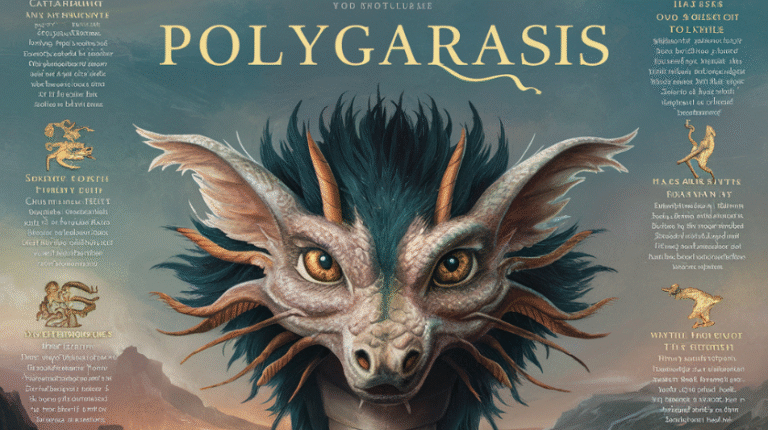The term Polygarasis has increasingly surfaced in various speculative and mythological discussions, drawing attention from researchers, folklore enthusiasts, and literary analysts alike. Though not widely documented in mainstream mythology or scientific literature, Polygarasis is often interpreted as a mythical or cryptid-like entity with deeply symbolic and metaphorical significance.
Rooted in speculative etymology, the word Polygarasis seems to derive from ancient linguistic constructions “poly” meaning many, and a possible root “garasis”, which could imply change, shift, or transformation. This leads to interpretations that associate the entity or concept with multiformity, evolution, and adaptability a creature or force capable of taking many forms across time and culture.
The Mythological and Folkloric Dimensions of Polygarasis
Regional Legends and Interpretations
In certain Eastern European and Balkan folk tales, Polygarasis appears as a shapeshifter, often cloaked in shadow, known to guard ancient secrets or forbidden paths in forested terrains. These stories portray Polygarasis not just as a creature but as a force of nature or protector of balance, surfacing when human transgressions disrupt natural order.
In Greek-inspired esoteric traditions, Polygarasis is depicted as a manifestation of inner turmoil, taking physical form in dreams or visions. In this interpretation, it serves as both a harbinger and a guide, leading individuals through cycles of rebirth or transformation, mirroring the metamorphic symbolism found in mythic creatures like the phoenix or chimera.
Symbolism in Cultural Archetypes
Across mythologies, creatures like Polygarasis serve as archetypal representations of chaos and harmony intertwined. It is not merely a monster but a liminal entity, existing between light and shadow, order and entropy. Scholars liken its mythos to trickster deities such as Loki from Norse mythology or Anansi from West African tales figures that blur moral boundaries to challenge complacency and provoke change.
Polygarasis in Literature and Contemporary Fiction
The conceptual figure of Polygarasis has made subtle yet profound appearances in modern speculative fiction, horror narratives, and psychological thrillers. Writers often incorporate it as a metaphysical antagonist, a shape-shifting presence that preys on human uncertainty, memory, or guilt.
In postmodern literature, Polygarasis may appear as an abstract, disembodied force that alters narrative structure itself, reflecting the poststructuralist idea that stories (and reality) are unstable, ever-shifting constructs. In this sense, the creature becomes a meta-symbol an embodiment of the author’s own struggle with meaning and interpretation.
Examples in Media
-
Graphic Novels: Independent publications have included Polygarasis-inspired beings as adversaries in worlds where reality itself bends and reassembles, playing into the visual medium’s strength in depicting transformation.
-
Video Games: Some fantasy role-playing games feature boss characters with similar themes ever-morphing creatures with abilities that adapt to the player’s style, making each encounter uniquely difficult.
-
Cinema: In psychological horror films, beings resembling Polygarasis manifest through symbolic hauntings, shape-changing apparitions, and dreamscapes that respond to the protagonist’s fears and memories.
Philosophical and Psychological Interpretations
The legend of Polygarasis has intrigued not only mythographers but also psychologists and philosophers, who interpret the figure as a projection of the human subconscious. Carl Jung’s theories on the “shadow self” find alignment here. Polygarasis becomes the externalized conflict between identity and change, ego and self, past and potential.
In existential philosophy, Polygarasis represents the anxiety of becoming, the idea that individuals are never static and must constantly redefine themselves in an indifferent or absurd world. Its amorphous nature serves as a symbol for the fluidity of existence, reminding us that permanence is an illusion.
Modern Occult and Esoteric Connections
Contemporary occult communities have adopted the idea of Polygarasis within ritual practice and symbolic frameworks, treating it as a guardian of thresholds between worlds, identities, or dimensions.
-
Chaos Magicians sometimes invoke Polygarasis as a symbolic construct, representing their desire to transcend rigid belief systems.
-
In tarot and symbolic divination, custom cards featuring Polygarasis are used to indicate transformation, hidden truths, or necessary disruption.
-
In some circles, Polygarasis is associated with astrological transits, particularly those involving Pluto or Neptune, planets tied to rebirth, secrecy, and the unseen.
Comparative Mythology: Polygarasis and Global Counterparts
To understand Polygarasis more deeply, we can compare it with similar mythological beings across various cultures:
-
Proteus (Greek): A sea-god who could change shape and evade capture symbol of elusive truth.
-
Kitsune (Japanese): Fox spirits that can shapeshift and influence human destiny.
-
Skinwalkers (Navajo): Shapeshifting witches or spirits with powerful and dark associations.
-
Baba Yaga (Slavic): A guardian of thresholds, equally capable of aiding or obstructing, reflecting duality much like Polygarasis.
Each of these entities shares the core attribute of metamorphosis and moral ambiguity, linking them conceptually to Polygarasis, which exists not as a direct equivalent but as a cultural echo of these archetypes.
Interpretive Flexibility: Why Polygarasis Resonates Today
In the 21st century, themes of identity, transformation, and instability are more relevant than ever. Polygarais embodies this cultural moment, where boundaries are blurred between digital and real, self and avatar, physical and virtual. Its mythos allows for endless reinterpretation, mirroring our complex and ever-evolving human experience.
Moreover, its open-ended narrative enables artists, writers, and thinkers to reshape it according to context. For some, it is a warning about unchecked ambition or forgotten history. For others, it is a guide to personal evolution, confronting the fear of change and offering symbolic resolution through transformation.
Conclusion: Polygarasis as Myth, Mirror, and Metaphor
The figure of Polygarasis, while enigmatic and largely speculative, offers a compelling lens through which we can examine human fears, cultural evolution, and philosophical dilemmas. It exists at the intersection of myth and metaphor, ancient belief and modern uncertainty. Whether treated as a literal cryptid, a symbolic force, or a psychological construct, Polygarasis continues to challenge, inspire, and haunt those who encounter its story.
As a shapeshifter both in form and meaning, Polygarais is less a fixed mythological being and more a dynamic cultural phenomenon constantly morphing to reflect the world around it.

